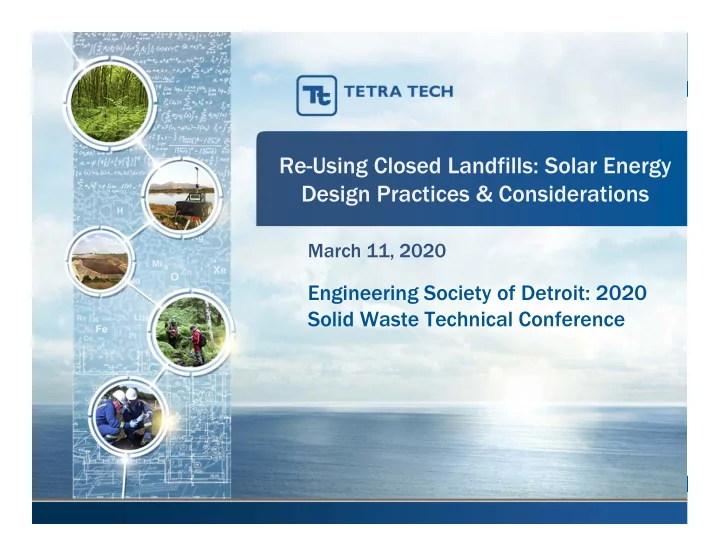

Re-Using Closed Landfills: Solar Energy Design Practices & Considerations March 11, 2020 Engineering Society of Detroit: 2020 Solid Waste Technical Conference
Presenter Information Drew Lent, P.G. Northeast Solar Services Lead Tetra Tech, Inc. Rochester, New York drew.lent@tetratech.com (585) 417-4002
Typical Solar Facility Components • Solar panels anchored to a racking system • Structural supports (driven piles, concrete ballast, augured piers) • Security fence and access roads Scotch Settlement Solar Project: Jefferson County, New York
Typical Solar Facility Components: Part 2 • String or central inverters • Interconnection transformers (concrete pad) • Battery Electric Storage System (BESS) • Underground or above ground wiring to the Grid • Performance monitoring & weather station RIT Solar: Rochester, New York
Why Solar on Landfills? • Leverage existing infrastructure • Offset existing environmental costs • Potential to generate $$ (lease payments) • Beneficial redevelopment of property Plainville Landfill Solar Project: Massachusetts
Low Impact Redevelopment Use Quiet Low profile (<10’ high: solar) Minimal vehicular traffic Limited liability/risk Low maintenance Can generate positive media visibility Los Angeles DPW Pine Tree Project
Regulatory Acceptance of Solar Energy on Brownfields • USEPA Re-Powering America’s Land Initiative www.epa.gov/re-powering • New York State: SEQR Exemption for solar projects (<25 acres) 6NYCRR § 617.5(C)(14) & (15)
Renewables on Brownfields: National Overview • 352 Renewables Projects on Brownfields (~ 1,710,000 MW of capacity DC) • 93% of Renewables on Brownfields are solar projects especially solar on landfills • Majority of Projects in Massachusetts, New Jersey and New York • Source: USEPA Re-Powering America’s Land Initiative Tracking Document: December 2019
Solar on Landfill Growth over Time First Solar on Landfill project completed in 2006 Majority of renewables on brownfields are solar landfill projects Greater financial and regulatory acceptance over time Source: USEPA Re-Powering America’s Land Initiative Tracking Document: January 2019
Solar on Landfills: Michigan 225 Solar on Landfill Projects Only 2 Michigan Solar on Landfill Projects (East Lansing and Eaton Rapids Landfills) Total energy capacity of <1 MW DC) 0.13% of the Nation’s current solar on landfill production capacity Saratoga Springs Landfill (New York) prior to solar development
What is the Ideal Solar Site? Solar utilizes large areas: 6 AC for ~1 MW Compatible zoning Geotechnically stable Local fiscal incentives available Close to point of grid interconnection Facilities with operating or former Landfill gas operations Saratoga Springs Solar Landfill Project, New York
Landfill Gas and Solar Interconnection • Interconnection to the utility grid is a significant solar development hurdle • Landfill Gas to Energy Facilities are already grid connected • Leverage LFG grid interconnection as landfill gas generation rates decrease Orange County, California
Landfill to Energy Version 2.0 • LFG to Energy facilities are typically designed for near peak load conditions • Landfill gas peak generation is greatest within about 5 – 7 years of disposal (ATSDR Landfill Gas Primer, 2001) • Majority of landfill gas generated within 20 years of disposal • Low cost grid interconnection capacity potentially available after several years of LFG to Energy operation Plainville Landfill, Massachusetts
Typical Solar Landfill Design Components No penetrating racking support structures (Concrete ballasted system) Can be installed on steep slopes Installation more expense than greenfield solar systems
Renewables Planning and Design Considerations • Strategize early and create team with experienced partners • Early communications with internal and external stakeholders (e.g., Municipality, Interconnection team, neighbors) • Design the facility landfill closure with solar redevelopment as an end use
Anticipated Design Studies for Solar Electrical Interconnection Impact Study Solar Assessment Study Environmental Due Diligence (Required by solar investors and developers) Geotechnical investigation Wetlands delineation and T&E species studies (if necessary) Storm water management study Bridgeton Landfill, Michigan
Strategies for Development of Solar Projects on Landfills Conduct a Feasibility Assessment: • Any post-closure use restrictions • Landfill cap construction (e.g., cap thickness, depth to barrier layer) • Evaluate facility compliance history and potential for corrective action (landfill repair) • Thickness of waste and potential for differential settlement East Bridgewater Landfill, Massachusetts • Local regulatory requirements (Many States are supportive of the concept)
Typical RCRA Subtitle D Final Cover System
Solar on Landfill Construction Considerations Keep High Ground Pressure Vehicles off the Landfill Footprint
Solar on Landfill Construction Considerations Use of Low Pressure Equipment is critical to avoid damage to the Landfill Final Cover System
Solar on Landfill Construction Considerations
Completed Solar on Landfill Project Saratoga Springs Landfill Completed Project
Solar Projects Advantages at Landfills Beneficial redevelopment of landfills with limited reuse options Leverages existing utility infrastructure Helps meet sustainability goals Promotes positive community relations Can generate redevelopment revenue for under-utilized Sites “We are continually faced with great opportunities which are brilliantly disguised as unsolvable problems.” Margaret Mead
Questions and Thank You
Recommend
More recommend